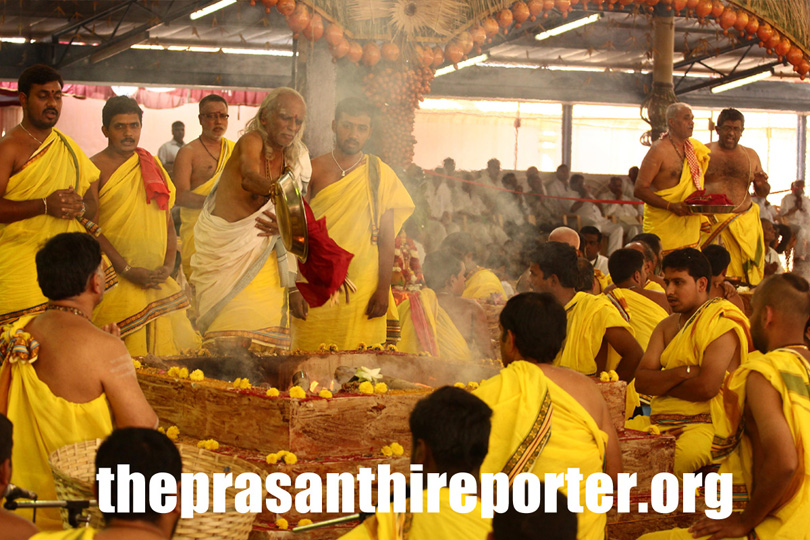It feels somewhat strange to write on this topic of Srimad Andhra Bhagavatham. Particularly so because at best I am just an enthusiast with very little knowledge of it. I have heard it with admiration for decades now from my now nonagenarian grandmother, who had no formal education but recalls still with aplomb several of the poems written in chaste Telugu by Sri. Bammera Pothana, the Telugu farmer-poet who lived in the 15th century near present day Warangal in the Telangana state.
The Telugu Bhagavatham is a celebrated work that is rich in literature, richer in devotion and richest in submission to God. It is a translation of the Bhagavatham, the story of Lord Vishnu's various earthly careers (avatars) and accomplishments written in Sanskrit by Veda Vyasa, the man to whom we owe the whole of the literature and scriptures.
Legend has it that Lord Rama Himself granted a vision to a meditating Pothana, and commanded him to undertake the translation of the Bhagavatham story into Telugu and promised all help! Exhorted thus, Pothana did a wonderful translation in which he didn't always stick to the original narrative but added his own imagination of the situation, lucidity of expression using a rarely seen command over Telugu grammar and usage.
Photo from http://pothana-telugu-bhagavatham.blogspot.in/2015/02/blog-post_10.html
For instance, in the episode of the Gajendra moksham, where the elephant battles the crocodile in a lake for thousand years and finally calls out to Vishnu in total surrender, Vyasa describes that Vishnu, upon listening to the cry of the elephant rushes to the spot on His Garuda and slays the crocodile, thus saving the elephant. Pothana however says, Vishnu goes running without even leaving the hand/saree pallu of Lakshmi that He was holding at the time, completely taken away by the surrender-filled cry of the elephant devotee. The narrative full of lovely grammatical usages, poetic beauty does appear to have compromised on the factual. But the real fact that needs to be appreciated is that Surrender begets the Lord and the elephant and crocodile merely are characters in that. Therefore, Pothana has done a translation-plus, if you will, in stead of merely substituting words. That in fact is the soul of this work.
In the six centuries that the Andhra Bhagavatham has existed in this world, it has filled the hearts of many a seeker, the foremost among them being Saint Thyagaraja Swami. It is said that study of Pothana Bhagavatam constituted a part of the daily prayer schedule of the epic composer. Little wonder then that their sentiments expressed for Lord appear equally sublime.
As recently as forty years ago, the popular poems from Pothana Bhagavatham used to be household treasures taught by parents and grandparents to toddlers and thus at least some of them were preserved in the public consciousness. As the need for English education grew and understandably so, this work began to fade from public memory and was a privilege of a few learned pundits and occasionally admired by enthusiasts such as yours truly. This was partly also because the lack of effective dissemination media post independence and in our quest for industrial jobs and modern civilization we neglected the great treasure to some extent.
But all is not lost. Thanks to the modern day technologies, we are able to hear the renderings and expositions in Televisions. There is a cultural resurgence of sorts and also the now somewhat-well-to-do middle class showing interest in our heritage. While there are many resources available on the internet, prominent being telugubhavatham.com, it could still be a challenge to sing these poems.
It is here that a very important gap has been filled by Sri. Malladi Suribabu of Vijayawada. Father of the famous carnatic duo, Malladi brothers, Sri. Suribabu is a great teacher of carnatic music. He has set hundreds of the padyams into tune and rendered with his rich voice. In the year 2014, he rendered more than 800 poems from the Pothana Bhagavatham after setting them to lovely ragas. This fantastic labor of love of Sri. Suribabu has now assumed the form of a CD and will soon be available for all.
This CD entitled "Bhagavatha Padya Madhurimalu" will be released in Rajamahendravaram (erstwhile Rajamundry) on the 03rd Dec 2015 at 10 AM. Venue: Vallabha Ganapathi Temple, Kalyan Nagar, Konthamuru, Rajamahendravaram. The detailed invitation in Telugu is given below.
All are invited!! If you are an enthusiast like me, come along and take part in spreading this lovely cultural treasure to ten more people in your circles. Let us do our bit to ensure future generations do not miss out on this great work which will enrich their lives a great deal. Do reach out to me through comments section if you want to stand up and be counted.
Invitation to Bhagavtha Padya Madhurimalu CD release ceremony
To paraphrase Bhagawan Sri Sathya Sai Baba "Bhagavatham chadivithe Baagavutam" - we will become good by reading Bhagavatham.
The event will also feature the release of the audio CD of compositions of Sadguru Narayana Teertha, rendered by the Malladi brothers - vidwans Sri. SreeRamPrasad and Sri. Ravikumar. This is the 4th volume that is being offered now.





